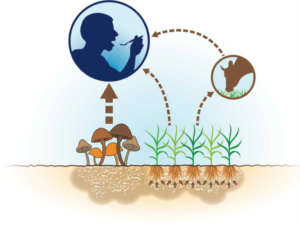
The Lesser-Known Antioxidant That Makes Mushrooms So Important to Health
Mushrooms are quite magical. Long revered for their nutritional value, they may actually hold the key to a longer life.
Usually considered the fruiting part of the fungi family, mushrooms are neither plant nor animal. But their health benefits have been enjoyed by ancient cultures worldwide for centuries.
While touted to be one of the only food sources of vitamin D (when exposed to sunlight) and to contain high doses of the antioxidant glutathione (vital to support detoxification and combat free radicals) it may be the lesser-known antioxidant ergothioneine (ergo) that is the real secret to their wide-ranging health benefits. Ergo may also be key to understanding why modern agricultural methods, that reduce the amount of fungi in the soil, are so damaging to our health.
A Complex Mix of Nutrients
Medicinal mushrooms are a hot topic these days with species such as Reishi, Cordyceps, Lions Mane, Chaga and Maitake being studied for their health properties. They are even being labelled as “functional foods” with a wide variety of supplements available to address specific health issues or provide therapeutic support.
The interest in mushrooms is well founded. Hundreds of clinical studies have shown mushrooms have anti-inflammatory, anti-viral, metabolic-regulating, immune-boosting and cancer-fighting properties.
The vast array of bioactive compounds in mushrooms include various vitamins and minerals, polyphenols, flavonoids and amino acids. They are particularly high in Beta-glucans which are credited with most of their immune-boosting properties as well as their positive effects on metabolic health and anti-tumor activity. In terms of their antioxidant content, it is usually the amounts of glutathione that gets attention.
The better-known antioxidant glutathione is often referred to as the master detoxifier given its critical role in protecting cells from oxidative damage and the toxicity associated with chemicals and infectious agents. The role of glutathione in the body was highlighted during the COVID-19 pandemic when it was found that N-acetylcysteine (NAC), a precursor enabling the body to synthesize glutathione, was an effective preventive and treatment for COVID-19.
Mushrooms Unique “Longevity Vitamin”
Mushrooms are unique in their biology, as they do not use photosynthesis like plants or ingest food like animals; rather, they live off of decaying matter. While this leads to a unique nutritional profile, most of the nutrients they contain can be found in other foods. However, Ergo has been found to be synthesized only by mushrooms and certain bacteria. It is not synthesized by plants, animals or the human body.
This almost exclusive source of ergo is what makes mushrooms so fascinating and significant to human health, Robert Beelman, Professor Emeritus of Food Science at Penn State University told The Epoch Times. Beelman has spent the majority of his career studying mushrooms and their impact on health.
While ergo was discovered decades ago, its importance was only recognized in 2005, when researchers made the pivotal discovery that humans (and other mammals) have a specialized transporter protein for ergo. The protein has been shown to be responsible for the rapid and efficient extraction of ergo from food in the intestines and delivery into red blood cells that carry it around the body. This specificity highlights the importance of ergo in the body.
Recently published research found that ergo is taken up directly into our cellular mitochondria. Mitochondria are each cell’s powerhouses, creating all the energy we need for cellular function. The research also found that ergo protects cells from disease and prevents mitochondrial damage.
Beelman supports the hypothesis first proposed by biochemist and molecular biologist Bruce Ames, that ergo be considered a “Longevity Vitamin” because a deficiency has been shown in a variety of degenerative conditions, including cognitive decline, neurological conditions, cardiovascular disease, and mitochondria disfunction.
Ames noted in a paper published in PNAS (the journal of the National Academy of Sciences) that ergo “acts as an adaptive antioxidant for the protection of injured tissues” and may play an important role in protecting cells against oxidative damage.
A Swedish study looking at cardiovascular disease in 3,236 individuals monitored more than 100 different metabolites to see if any could predict cardiac risks. Higher ergothioneine levels were found to be an independent marker for lower risk of cardiovascular disease and mortality.
These studies of ergo have also shown that it builds up gradually in the body and is excreted very slowly. This fact, together with the specialized transporter protein, implies it has an important physiological role even if the extent of its functions is not yet fully known.
While many studies have focused on the health effects of mushrooms in general, these newer studies focus on ergo—its action in the body and availability to cells.
Comparing Average Ergo Levels by Country
An analysis led by Beelman himself, looked at mushroom consumption in the US compared to four European countries and then estimated the ergo consumption it implied. It was found that Americans on average consume around 1mg per day of ergo while Italy for example consumed on average over 4mg per day. These lower intakes were shown to correspond to lower life expectancies and greater prevalence of neurological disorders.
Taken alone a causal relationship cannot be established from this study, but when looked at in light of the growing research on ergo itself, it presents an interesting picture.
More studies are clearly needed but evidence is building on the vital role ergo plays in the body and its wider implications for mushroom consumption.
The Link Between Soil Health and Human Health

The intrigue builds when you consider the role of fungi and bacteria in our soil. Healthy untouched soil is teeming with trillions of bacteria plus the mycelium of mushrooms and fungi. Mycelium is similar to a plant’s root system and consists of an interwoven mass of tiny hyphae which absorb nutrients from the soil. They then pass nutrients to other parts of the colony and through an intricate exchange with plant roots.
Beelman describes how this mechanism seems to deposit ergo in healthy soil which is then taken up by plants or crops being grown. It may also explain how pasture-raised animals eating grass grown on untilled soil that has a rich fungal network beneath it, have levels of ergo in their cells but factory-farmed do not.
Studies have shown that ergo is found in a few plant foods, most notably tempeh, which is a soybean product fermented with fungi. Smaller amounts are found in certain kinds of asparagus, depending on the conditions in which they are grown. Some beans and oats have measurable amounts. While these foods cannot synthesize ergo, they are able to take it up from the soil.
While there is a growing interest in regenerative agriculture these days, the emphasis tends to be on the sustainability of the soil and on avoiding chemical pesticides which are toxic to humans. This is certainly a noble endeavor but enhancing the levels of ergo needs to be added to the conversation according to Beelman.
Regenerative practices include a reduction in the soil disturbance through no-till approaches, cover cropping and crop rotation all of which contribute to a build-up and diversity of organic matter.
So far experiments have focused on tillage practices (ploughing) used in industrial agriculture. They show that the greater the intensity of soil tilling, leads to an associated reduction in fungi biomass and a reduction in ergo concentration in the crops grown. Beelman for one, would like to see further research in this area as well as into the ergo concentrations in organic produce and the entire food supply.
The growing awareness of ergo’s importance to human health further highlights the need to know where your food came from, as outlined in the book “What Your Food Ate” by geologist David Montgomery and biologist Anne Bikle. I agree with Professor Beelman when he says this book should be recommended reading for anyone involved in agriculture, particularly if they want to improve sustainability and the nutritional quality of the food being grown.
Can You Test Your Ergo Levels?
Bringing the discussion back to you as an individual, the impetus to adjust your food consumption may depend on the ability to measure your own levels of ergothioneine much like the encouragement to measure your vitamin D levels in recent years due to the accepted broad impact of vitamin D on our health.
Unfortunately, there is currently no commercially available test to measure the amount of ergo in your blood as a predictor of your risk for a variety of degenerative conditions. Beelman thinks this should change in the future. He comments that the testing is not difficult if you have the right equipment.
Perhaps ergo-testing will become as common and insightful as your vitamin D level in future.
How to Increase Your Ergo Consumption
Obviously the simplest approach is to eat mushrooms as often as possible given their unique role in ergo production. All mushrooms contain ergo but some have far higher quantities than others. Golden oysters, porcini, and shitake are good choices, particularly if you can source them from a farmer’s market and know them to be from an entirely clean source. Mushrooms are especially absorbent of any contaminants in the air or soil like pesticides so look for organic as a minimum standard.
Those little white button mushrooms you might see on a pizza are one of the lowest sources and unlikely to be organically grown. See below for suggestions to incorporate mushrooms into your diet.
Factory farmed animals and conventionally grown plants have little to no ergothioneine. Regeneratively grown produce usually comes from small farms that use natural methods to control pests and keep the soil healthy. This means that the networks of fungi in the soil can stay intact and better convert decaying plant matter into important nutrients such as ergo. Organic and pasture-raised are also good options.
While the healthier options are often more expensive, the health benefits are worth it – would you rather pay the farmer or the pharmacy?
As with any identified nutrient, ergo is available in commercial supplements. (See ETA for independent recommendations). Make sure to research how the ergo is obtained and its measurable bioavailability in your body. Still, don’t give up on trying to eat mushrooms for all their other fantastic properties and health benefits.
Closing Thoughts
Ergothioneine, with its unique source and evidence of importance to human health, emphasizes the critical role mushrooms and bacteria have in this ecosystem we call nature and life. Man may be the top of the food chain but we cannot survive without the natural system that has been designed to support us. Our good health depends on embracing all aspects of what God has provided even to the elements of decay like fungi, and the vilified like bacteria. Our minds cannot fathom the majestic interaction of nature but embracing mushrooms in your diet is a no-brainer.

Suggestions to Eat More Mushrooms
Portobello mushrooms make a great alternative to a burger patty – grill or sauté a whole portobello, add some grilled onions and avocado, and nestle inside the bun of your choosing with mustard or mayo.
Add some finely chopped shiitake or cremini mushrooms to your ground beef in just about any recipe.
Add some protein powder featuring mushrooms into your smoothies.
Try some magnificent oyster mushrooms from the local farmer’s market, sautéed in garlic and butter, and put on top of a grass-fed steak.
Embark on a project to grow your own mushrooms at home. For safety, it’s best to start with a kit from a reputable company.
A version of this article was originally published by The Epoch Times. Link to original.



